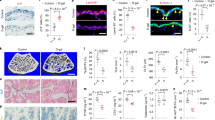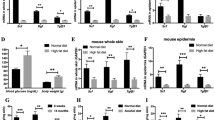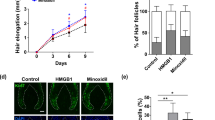Abstract
The cellular and molecular mechanisms underlying the effects of aging on human cutaneous wound healing are poorly understood, and the possible role of reproductive hormones in this process has never been investigated. We report that aging in healthy females was associated with a reduced rate of cutaneous wound healing, but an improved quality of scarring both microscopically and macroscopically, and with reduced levels of transforming growth factor-β1 (TGF-β1) immuno staining and steady-state mRNA in the wound. These age-related changes were reversed by the systemic administration of hormone replacement therapy (HRT). Moreover, ovariectomized young female rodents exhibited a marked delay in repair of acute incisional wounds, which was reversed by the topical application of estrogen. The cellular mechanism underlying these changes appears to involve an estrogen-induced increase in latent TGF-β1 secretion by dermal fibroblasts. These results suggest that both the rate and quality of wound healing depend on reproductive hormone levels.
This is a preview of subscription content, access via your institution
Access options
Subscribe to this journal
Receive 12 print issues and online access
$209.00 per year
only $17.42 per issue
Buy this article
- Purchase on Springer Link
- Instant access to full article PDF
Prices may be subject to local taxes which are calculated during checkout
Similar content being viewed by others
References
Ashcroft, G.S., Horan, M.A. & Ferguson, M.W. A review: The effects of ageing on cutaneous wound healing in mammals. J. Anat. 187, 1–26 (1995).
Whitby, D.J. & Ferguson, M.W.J. Immunohistochemical localization of growth factors in fetal wound healing. Dev. Biol. 147, 207–215 (1991).
Frazier-Jensen M.R. et al. Estrogen suppression of connective tissue deposition in a murine model of peritoneal adhesion formation. J. Immunol. 156, 3036 (1996).
Bolognia, J.L. Aging skin. Am. J. Med. 98, 99s–l03s (1995).
Schmidt, J.B. et al. Treatment of skin ageing symptoms in perimenopausal females with estrogen compounds; A pilot study. Maturitas 20, 25–30 (1994).
Pierard, C.E., Letawe, C., Dowlati, A. & Pierard-Franchimont, C. Effect of hormone replacement therapy for menopause on the mechanical properties of the skin. J. Am. Ceriatr. Soc. 43, 662–665 (1995).
Oursler, M.J. et al. Modulation of transforming growth factor-beta production in normal human osteoblast-like cells by 17 beta-estradiol and parathyroid hormone. Endocrinology 129, 3313–3320 (1991).
Piccinni, M.P. et al. Progesterone favors the development of human T helper cells producing Th2-type cytokines and promotes both IL-4 production and membrane CD30 expression in established Thl cell clone. J. Immunol. 155, 128–133 (1995).
Pierce, G.F. et al. Platelet-derived growth factor and transforming growth factor-β enhance tissue repair activities by unique mechanisms. J. Cell Biol. 109, 429–440 (1989).
Sporn, M.B. & Roberts, A.B. Transforming growth factor-β: Recent progress and new challenges. J. Cell Biol. 119, 1017–1021 (1992).
Beck, L.S. et al. One systemic administration of transforming growth factor-β1 reverses age- or glucocorticoid-impaired wound healing. J. Clin. Invest. 92, 2841–2849 (1993).
Shah, M., Foreman, D.M. & Ferguson, M.W.J. Control of scarring in adult wounds by neutralising antibody to transforming growth factor β. Lancet 339, 213–214 (1992).
Colletta, A.A. et al. The growth inhibition of human breast cancer cells by a novel synthetic progestin involves the induction of transforming growth factor beta. J. Clin. Invest. 87, 277–283 (1991).
Yang, N.N. et al. Estrogen and raloxifene stimulate transforming growth factor-β3 gene expression in rat bone: A potential mechanism for estrogen- or ratox-ifene-mediated bone maintenance. Endocrinology 137, 2075–20 (1996)
Malet, C. et al. Estradiol and progesterone receptors in cultured normal human breast epithelial cells and fibroblasts: Immunocytochemical studies. J. Clin. Endocrin. Metab. 73, 8–13 (1991).
Reed, M.J. et al. TGF-beta 1 induces the expression of type I collagen and SPARC, and enhances contraction of collagen gels, by fibroblasts from young and aged donors. J. Cell. Physiol. 158, 169–179 (1994).
Ligthart, G.J. et al. Admission criteria for immunogerontological studies in man: The SENIEUR protocol. Mech. Ageing Dev. 28, 47–55 (1984).
Ashcroft, G.S., Horan, M.A. & Ferguson, M.W.J. Ageing is associated with reduced deposition of specific extracellular matrix components, an up-regulation of angiogenesis, and an altered inflammatory response in a murine incisional wound healing model. J. Invest. Dermatol. 108, 430–437 (1997).
Overall, C.M. Repression of tissue inhibitor of matrix metalloproteinase expression by all-trans-retinoic acid in rat bone cell populations: Comparison with transforming growth factor-β1. J. Cell. Physiol. 164, 17–25 (1995).
Danielpour, D., Dart, L.L., Flanders, K.C., Roberts, A.B. & Sporn, M.B. Immunodetection and quantitation of two forms of transforming growth factor-beta (TGF-βl and TGF-β2) secreted by cells in culture. J. Cell. Physiol. 138, 79–86 (1989).
Chomczynski, P. & Sacchi, N. Single-step method of RNA isolation by acid guanidtnium thiocyanate-phenol-chtoroform extraction. Anal. Biochem. 162, 156–159 (1987).
Tarnuzzer, R.W. et al. Competitive RNA templates for detection and quantitation of growth factors, cytokines, extracellular matrix components and matrix metalloproteinases by RT-PCR. Biotechniques 20, 670–674 (1996).
Author information
Authors and Affiliations
Rights and permissions
About this article
Cite this article
Ashcroft, G., Dodsworth, J., Boxtel, E. et al. Estrogen accelerates cutaneous wound healing associated with an increase in TGF-β1 levels. Nat Med 3, 1209–1215 (1997). https://doi.org/10.1038/nm1197-1209
Received:
Accepted:
Issue Date:
DOI: https://doi.org/10.1038/nm1197-1209
This article is cited by
-
Characteristics of Fetal Wound Healing and Inspiration for Pro-healing Materials
Biomedical Materials & Devices (2024)
-
Correlation of bioactive components of platelet rich plasma derived from human female adult peripheral blood and umbilical cord blood with age
Scientific Reports (2023)
-
Male or female sex: considerations and translational aspects in diabetic foot ulcer research using rodent models
Molecular and Cellular Biochemistry (2023)
-
Vasculature atrophy causes a stiffened microenvironment that augments epidermal stem cell differentiation in aged skin
Nature Aging (2022)
-
Evaluation of the Number of Follow-up Surgical Procedures and Time Required for Delayed Breast Reconstruction by Clinical Risk Factors, Type of Oncological Therapy, and Reconstruction Approach
Aesthetic Plastic Surgery (2022)



